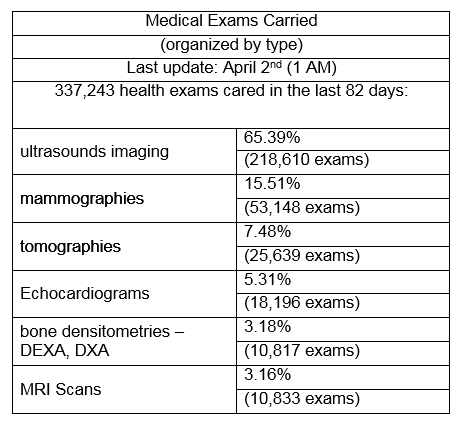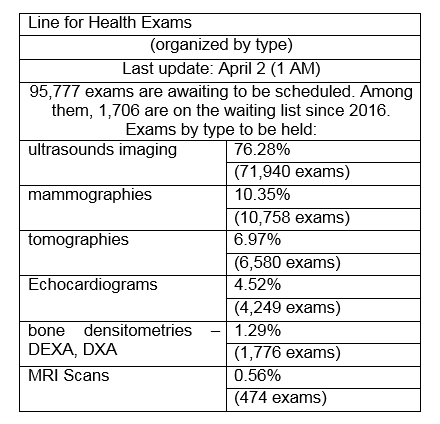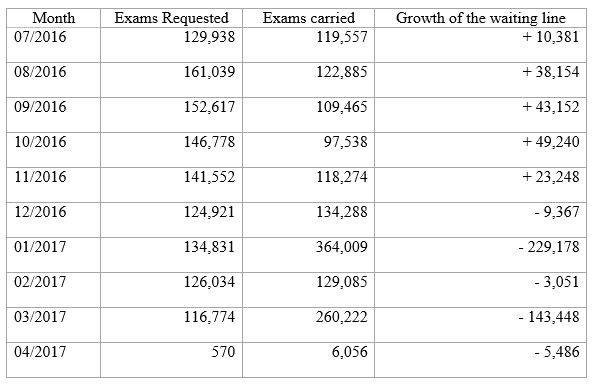In less than three months, the “Corujão da Saúde” (Health Owl) has attended to 99.65% of the 485,300 health exams in line since last year, essentially eliminating the line. The program, which started on January 10th, has conducted 342,741 medical procedures, which is equivalent to one patient receiving medical care every 20 seconds.The treatment is held in private, public and philanthropic hospitals and health clinics that offer extra health exams in alternative hours from 12AM to 6AM, in accordance with the spare capacity of each place.
“Our project met our commitment. A good health management allowed the “Corujão da Saúde” to be implemented. There is no miracle, nor a search for extraordinary resources. We identified the problem, built a working group and made agreements in order to help the population”, said Mayor João Doria.
On December 31st, 2016, the municipal health system listed 485,300 medical exams on the line. Of those, only 1,706 (0.35%) have not been attended to, however, they have been scheduled. The ultrasounds imaging are the most performed procedures, accounting for 65.39% of the total. It is followed by mammographies (15.51%), tomographies (7.48%), echocardiograms (5.31%), and bone densitometries – DEXA, DXA (3.18%), and MRI Scans (3.16%).

From the total of health exams, 79.78% were carried in municipal facilities and 20.22% in affiliated facilities. There were 69,328 health procedures carried in affiliated services, with 18,773 medical care received in the Santa Casa Hospital in Santo Amaro, the facility that held the highest number of medical care. Another prominent one is the Syrian-Lebanese Hospital, responsible for almost 20% of the patients.
In 83 days, the “Corujão” (All-Nighter) managed to reverse the increasing pattern of waiting lines in the second semester of 2016. If, from July to December 2016, there was an increase of 154,408 procedures, totalizing 485,300, the first 3 months of 2017 registered more exits than entrances in the line. As a whole, there were 381,163 exams more that exited the line, than ones that entered.. Considering the sum of 2016 and 2017 demands, 893,660 no longer waited for exams with the program.
“This is a clear demonstration that it’s possible to improve São Paulo’s health in short-term and, consequently, another sample of the City Hall’s efforts to obtain advances that enable more achievements to the city on citizen’s healthcare”, says the Secretary Wilson Pollara (Health).
As it managed the line, the action verified that 77,820 people no longer needed to take medical procedures, for various reasons. The 68,099 patients that had waited for more than 6 months for a scheduling were forwarded to medical reevaluation, in order to renew the request and, consequently, have their exams scheduled.
In total, 366,374 procedures were scheduled during this period. Some patients return to waiting queue due to not being present, forgetting documents, or even because of not performing the needed preparatory procedures, such as fasting for example.
The 2017 demand registered that 86,918 exams are awaiting scheduling and are going to be fulfilled in up to 30 days. Within this group, 76.28% needed an ultrasound imaging exam, 10.35% an echocardiogram, 6.97% an MRI scan, and 1.85% a tomography or bone densitometry.
The initial expectation was that the whole program received R$ 17 million in investments. Currently, the Secretariat of Health works with a R$ 9 million expectation, but only at the program’s closing will it be possible to know the precise investment amount. The payment of procedures follows the SUS (National Health Service) table.


My Corujão
To assist the users of municipal health network, the São Paulo City Hall launched on April 3rd the platform “My Corujão”, a website that allows the patient to follow up on their exam’s information. For assistance, patients simply need to insert the SUS card number and their date of birth.
Update (April 6th): data regarding exams and the line by type were updated, because the sum refers to the data of April 02nd.
Update (April 27th): this text was modified for better understanding of statistics, since some of the data described in the text as people refer to exams.
For Portuguese version, click here.


